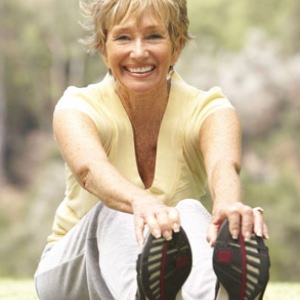A very common symptom experienced by menopausal women is hot flushes. This can often have an impact on one’s day to day life in many ways. The important thing to remember is that there are many things that can be done to naturally minimise these, one of these is a healthier lifestyle. More specifically, exercise is thought to play a major part in alleviating these symptoms, as this can have a positive impact on both the physical and mental issues associated with the menopause.
It is thought the severity of the hot flushes may be due to an imbalance in the adrenal glands (situated just above your kidneys), which produce the neurotransmitters adrenaline and noradrenaline and the hormones cortisol and DHEA as these glands are responsible for balancing all the other hormones in the body, namely estrogen and progesterone that are involved in the menopause.
How exercising has an effect on hormonal levels:
Exercise definitely has an effect on hormonal levels in a number of different ways, which can either have a positive effect on the incidence of hot flushes, or a negative one. In some cases exercise can increase estrogen levels, which helps to minimise hot flushes, as these are thought to be caused by a deficiency of this hormone. On the other side of this, exercise, especially if it is intensively cardio can lead to excessive adrenaline levels in the body, thus increasing the likelihood of a hot flush, due to the impact this has on the adrenal glands and the fact these glands are responsible for controlling the sex hormones estrogen and progesterone. This is made even more likely if you have an underlining imbalance in these adrenal hormones.
How different forms of exercise impact in different ways:
Due to the different ways different forms of exercise impact on the hormonal levels in the body, it is important to note that some forms are better than others in certain types of women experiencing hot flushes.
Things such as high intensity cardio, such as interval training, running, or the using the gym for cardio workouts may have a negative impact on hot flushes if your adrenal glands are not able to deal with the excess adrenaline, however in women who have no underlining adrenal hormone imbalances then some forms of cardio are a good thing, such as cycling or swimming, and swimming also has the added benefit of cooling you down if you are experiencing any hot flushes.
Other forms of exercise that would be beneficial are weight bearing exercises, such as walking or strength training, which would also help to prevent the incidence of osteoporosis by increasing estrogen and increasing bone density where there is a natural decline in estrogen levels that may lead to this. Other forms of exercise like yoga would also be beneficial and for all types of women, as these are not intensively cardio, help to balance hormones, help prevent osteoporosis and reduce any stress experienced due to the menopause.
In some cases weight lifting may lead to an increased risk of osteoporosis, but this is normally in the case of excessive repetitions, using too heavy weights, or not varying the type of exercises you do, as this may exert extreme pressure on the joints, and thus bones even causing injuries that may lead to this in later life.
Other lifestyle factors:
Other factors that may help alongside exercise to alleviate hot flushes are a change in your diet. Introducing things like omega 3, eating organic food and increasing lean animal and plant proteins, whole grains and antioxidants may be beneficial. Diets low in saturated fats are most likely beneficial too, due to them being rich in certain vitamins and minerals that help to balance hormonal levels and because they have an anti-inflammatory effect in the body, which may lead to less hot flushes.
There are certain foods that may be beneficial to avoid such as alcohol, spicy foods, lemon, chocolate, caffeine, hot beverages, sodium nitrate (in bacon, ham and cured meats), monosodium glutamate and sulphites (found in red wine). Also dried fruits and cheddar cheese (which also contain sulphites) should be avoided if these lead to any hot flushes.
Other things that may trigger hot flushes are stress, hot environments, tight clothes, or smoking, as these all affect hormonal balance or trigger the hot flushes by overheating, or by causing inflammation, therefore avoiding any of these may help, or even minimising some of them may be beneficial.

